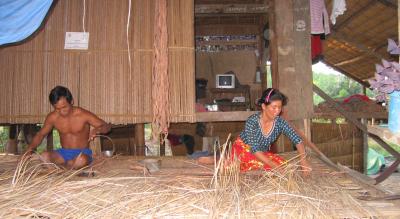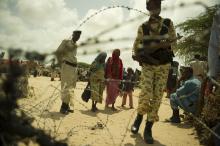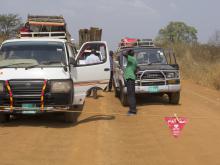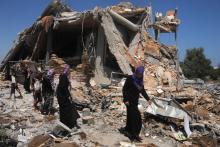Case prepared by Jennifer Hickey and Nicole Schladt, J.D. students at Emory University School of Law, under the supervision of Professor Laurie Blank, Emory University School of Law; with the contribution of Jemma Arman and Isabelle Gallino, LL.M. students at the Geneva Academy.
A. THAILAND MINE ACTION CENTER
The Royal Thai Government recognizes that landmines and UXO [unexploded ordnance] are a major obstacle to development and economic growth in rural border communities. The Royal Thai Army and Navy have been conducting demining operations in areas along the borders since 1987. In August 1998, the Office of the Prime Minister of Thailand issued an Order No. 151/1998 forming the National Mine Action Committee (NMAC), chaired by the Prime Minister and comprising all major government ministries and departments, to develop policies and to monitor the obligations set forth by the treaty, including:
- Implementation of the law prohibiting the use of anti-personnel landmines;
- Implementation of demining operations and mine risk education (MRE);
- Establishing the minimum quantity of anti-personnel landmines to remain in Thailand for education and demining purposes, and the destruction of all anti-personnel landmine stocks in excess of this established minimum; and
- Implementation of the landmine victim assistance activities.
B. LANDMINE REPORT 2000: THAILAND
Key developments since March 1999: The Mine Ban Treaty entered into force for Thailand on 1 May 1999. Thailand created a National Committee for Humanitarian Mine Action in February 2000. Thailand has prepared a Master Plan for Humanitarian Mine Action for 2000-2004, and has commissioned a Level One Survey. In May 1999 Thailand destroyed 10,000 antipersonnel mines; it has developed a plan for destruction of all stockpiled AP mines.
[...]
Landmine Problem
According to the government, about 400,000 people in at least 148 Thai villages in 48 districts are affected by antipersonnel mines. Mine-affected land includes mainly agricultural lands, village lands, and parts of national forests.
As noted in Landmine Monitor Report 1999, a survey conducted by the RTA and the RTN in 1998 concluded that in all border areas 796 square kilometers are mined.
[..]
Landmine Casualties
TMAC has published a list of mine victims, including fifty-six fatalities, covering the period 1969-1999. Only recently have efforts been made to compile records across the country for the total number of landmine casualties, both military and civilian. TMAC reports in twenty-two provinces, over a thirty-year period, a total of 1,849 mine deaths and injuries, including 502 injured in the area occupied by the Third Army. TMAC has also requested official reports from the Ministry of Health. The initial reports available of military and civilian casualties appear to be incomplete.
[...]
Recently the national press has begun reporting injuries and deaths due to landmines, leading to greater public awareness of the problems of mines and problems for victims. […] Much publicity was given to an elephant working in a forest near the western border in Tak province that stepped on a landmine and required a prosthetic leg. […]
C. MINE AWARENESS IN THAILAND: A REVIEW OF NEEDS AND STRATEGY
[...]
Mine and Unexploded Ordnance Contamination
[...]
Article I. The impact of mines and unexploded ordnances
Mines and UXO have both a direct and a socio-economic impact in Thailand. The Thai living in affected communities along the various borders have been forced to live with mine and UXO contamination for many years and have therefore adopted certain coping strategies.
The Landmine Impact Survey (LIS) recorded 3,472 mine and UXO Thai victims in Thailand covering all periods of armed conflict, of whom some 1,500 were killed. At least 350 people were killed or injured between May 1999 and May 2001, most along the border with Cambodia. The vast majority of incidents are said to result from mines as opposed to UXO.
Some 90 per cent of the total victims were adult males, mostly farmers and labourers collecting forest resources or farming along the border; a small number of women were also killed or injured. A brief analysis of 195 recorded victims during the 18-month period to May 2001 revealed 56 fatalities, and a total of 72 amputees among the survivors. Two-thirds of these 195 victims were reportedly killed or injured collecting food or water.
[...]
Humanitarian Demining
Humanitarian demining in Thailand is a combination of mechanical demining, mine detection dogs, and manual demining. To date, almost all mine clearance in Thailand has been carried out by the TMAC, with the Chatichai Choonhavan Foundation also contributing a small scale capacity. There are two operational HMAUs working on the Thai-Cambodian Border, each made up of 100 staff, including deminers, who were trained by the Thai Royal Academy with support from the United States and RONCO. There are plans to train, equip and deploy an additional three HMAUs to focus on the other areas affected in Thailand, namely the Thai-Myanmar, Thai-Lao and Thai-Malay Borders.
Landmine Stockpile Destruction
Thailand is effectively implementing its obligations to destroy anti-personnel mine stockpiles under its jurisdiction or control, and is expected to complete destruction ahead of the deadline of May 2003. It is retaining just under 5,000 anti-personnel mines for the permitted purposes of training in mine detection and clearance.
[...]
D. IMPACT OF LANDMINES ON CHILDREN IN EAST ASIA AND PACIFIC REGION
[...]
“In Thailand, the Thailand Mine Action Centre and three NGOs conducted MRE [mine risk education] activities, reaching about 77,000 persons.”
[...]
E. COUNTRY REPORTS ON HUMAN RIGHTS PRACTICES: THAILAND (2001)
[...]
In past years, conflicts along all four of the country's borders as well as internal insurgency resulted in the placement of landmines, and, over the last 2 years, 346 persons have been killed or injured in landmine or unexploded ordnance incidents. The Government is strongly committed to removing all landmines and unexploded ordnance, and the country's security forces have not laid landmines in recent years.
[...]
F. COUNTRY REPORTS ON HUMAN RIGHTS PRACTICES: THAILAND (2010)
[...]
According to the Thailand Mine Action Center, during the year there was one death and 23 injuries due to land mines, occurring in Buriram, Chanthaburi, Sakaew, Sisaket, Ubon Ratchatani, Tak, and Trat provinces. The government continued public awareness campaigns, including sending landmine awareness teams to the affected villages and landmine education teams to local schools to inform students of the risk associated with land mines and instruction on how to avoid injuries.
[...]
G. CLEARING THE MINES 2016
[...]
A 2001 Landmine Impact Survey (LIS) identified 27 of Thailand’s 76 provinces, and more than 500,000 people, as mine/ERW-affected, estimating total mine/ERW contamination at 2,557km2. Thailand’s revised Article 5 deadline extension request, submitted in 2008, claimed it had released 1,355km2 of this area, leaving a total of 1,202km2 of suspected hazardous area (SHA). This included an estimated 528km2 of “real minefield” requiring manual clearance.
In 2015, Thailand reported that 16 of 77 provinces are mine affected (see Table 1), but the precise extent of contamination is not known. Thailand estimated total contamination at the end of the year at 450km2 affecting 314 areas, down from 474km2 affecting 328 areas at the end of 2014, a drop of 23km2 , although TMAC reported releasing almost double this amount of land in 2015 [...]
Land release
Thailand released a total of 41.72km2 in 2015, two-thirds more than in the previous year, reflecting a more efficient application of land release methodologies and accelerating clearance. TMAC’s new director, General Wittaya, expressed confidence that Thailand could release 35km2 of mined area a year.
[...]
Discussion
I. Classification of the Situation and Applicable Law
1. Does the classification of the situation during which the landmines were laid, and who laid them, matter for the demining obligations of Thailand? Why?
II. Conduct of Hostilities
2. Are anti-personnel mines
per se unlawful under IHL? In what circumstances would the use of anti-personnel mines constitute an unlawful method of warfare? (
P I, Arts 35,
51;
CIHL Rules 1,
11,
12,
70,
71).
3. What does customary law prescribe about the usage of anti-personnel mines? (
CIHL Rules 81;
82 and
83). Is a State obliged to remove landmines after the end of active hostilities? Is there any difference between the customary law governing IACs and NIACs in this respect?
III. Elements Contributing to Respect for IHL
6. What might motivate a government to ban anti-personnel mines? What are the long-term impacts of laying anti-personnel mines? On civilians? On development? On the economy of a region?
7. (Document B) How can the local press contribute to respect for IHL? What impact do you think it had in the case at hand?
8. How might a non-state actor be persuaded not to use landmines? What do you think of the wide-reaching mine risk education mentioned in Document D? Can landmines be used in a discriminatory way?






